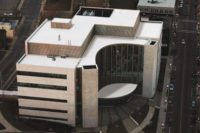California Energy Code Regulation Spurs New Roofing Trends

Recent revisions to the California Building Code, Title 24, Part 6, include new prescriptive cool roof requirements in select climate zones for low-rise residential steep-slope roofs. Photos courtesy of Boral Roofing.

Clay and concrete roof tiles typically provide excellent solar reflectivity, thermal emissivity and possess a high thermal mass.






As residential developers and builders in California gear up to meet this year’s increased demand for housing, new changes in the state’s energy code will shape their decisions and impact the industry’s roofing trends for 2014 and the foreseeable future.
The Race Toward Net Zero Energy
Revisions to the California Building Code, Title 24, Part 6, were implemented in January as part of the state’s initiative to achieve net zero energy in residential construction by 2020. At the heart of these changes is the goal of reducing energy consumption by minimizing heat transfer through the building envelope. As such, the prior regulations underwent careful evaluation, including a closer look at the standards pertaining to residential roofs. Since the roof receives a substantial amount of direct radiation from the sun, it is obviously a critical component of the building envelope when it comes to preventing heat entering the home. To that end, a major revision of the energy code involves new prescriptive cool roof requirements in select climate zones for low-rise residential steep-slope roofs. The change has resulted in a sizable increase in the aged Solar Reflectance Index (SRI) for all roofing materials — from 10 to 16 or greater.
As the state and consequently the homebuilding industry race toward net zero energy in 2020, cool roofs are playing a crucial role in the equation. To meet updated code requirements, builders and developers need to be more selective than ever when choosing roofing options.
The Case for Clay and Concrete Roof Tile
There are cool roof products available in a range of materials. Among them, clay and concrete roof tile offer a number of advantages over alternatives. Compared to other commonly installed residential roof systems, clay and concrete roof tiles typically provide excellent solar reflectivity, thermal emissivity and possess a high thermal mass. Since tiles do not tend to get too hot or too cold, they stay within a more modest temperature range, allowing them to act as an insulating body and thermal barrier for the roof. Additionally, high-profile clay and concrete roof tile offer even greater energy efficiency due to the air pathway they provide — heat that penetrates may be channeled above the deck and out through the ridge.
Under the updated code, the preferred method for new buildings is the Performance Path using California Energy Commission-approved software. The input variables for steep-slope roofing include reflectivity and emissivity, and whether or not a radiant barrier is being used. Reflectivity and emissivity values for each color are listed by the Cool Roof Rating Council (CRRC). For those products not listed by the CRRC, the default reflectivity value for clay and concrete tile is 10 percent, as compared to 8 percent for asphalt shingles.
Sustainability Benefits
Given their capacity for reflectivity and emissivity, clay and concrete tile are proving to be a favorite among developers and builders seeking compliance with the revised energy code. These cool roof products also offer other sustainability benefits that contribute to LEED point opportunities. Not only do they incorporate inherently green materials, but they can also be utilized for rainwater capture and reuse. Some concrete tiles even reduce the formation of smog and other pollutants from the atmosphere while helping to inhibit mold and algae growth. And, both clay and concrete tiles have a lower carbon footprint and lower manufacturing footprint than many other building materials. Their durability, which includes fire and hail ratings, also means less maintenance throughout the life of the roof. Once the tiles need to be replaced, they can be completely recycled. While more than 11 million tons of asphalt shingle waste is generated and placed in U.S. landfills each year, more than 140 million tons of concrete are recycled in the United States annually.
Design Appeal
Clay and concrete tiles are also popular from an aesthetics viewpoint since they are available in a wide range of colors, textures and profiles. This makes it easier for builders and developers to cater to the design demands of customers while still meeting the new energy code standards. Clay tile is timeless with neutral tones, but it also offers the distinct design advantage of being easily blended together to make custom colors, giving builders and developers the ability to provide personalized roofing options to homebuyers. Similar blends can be achieved with concrete tile, and the California market is experiencing a shift in preference for unique manufactured blends with elements of terra cotta, chocolate brown and neutral buff that are compatible with most wall and stucco colors.
The variety of textures and profiles also adds to the design appeal of clay and concrete tile, which can be used to create everything from traditional Old World looks to sleek, contemporary styles. These products can even be used to emulate other roofing materials, such as slate and wood shake.
One design trend on the multifamily side is the use of different concrete profiles on adjacent units to create a varied town-like appearance. A common combination is the mixture of flat-profile tiles with high-profile tiles to keep a project from looking too boxy or plain.
Cost Savings
The use of clay and concrete roof tiles also makes sense from a cost perspective. With the new regulations, developers and builders are challenged with fewer options. Since the code change is driven by the state and not consumers, it comes down to a cost analysis of how builders can deliver an attractive, high-performance house without breaking the bank. And the higher the reflectivity of the roofing materials, the more bang for the buck.
Though California does not require cool roofs with new construction, their inclusion will go a long way to help builders and developers achieve the energy standards the newly revised code mandates. As such, the demand for clay and concrete tiles will only continue to grow as the state’s race toward net zero energy influences roofing trends for years to come.
Looking for a reprint of this article?
From high-res PDFs to custom plaques, order your copy today!









